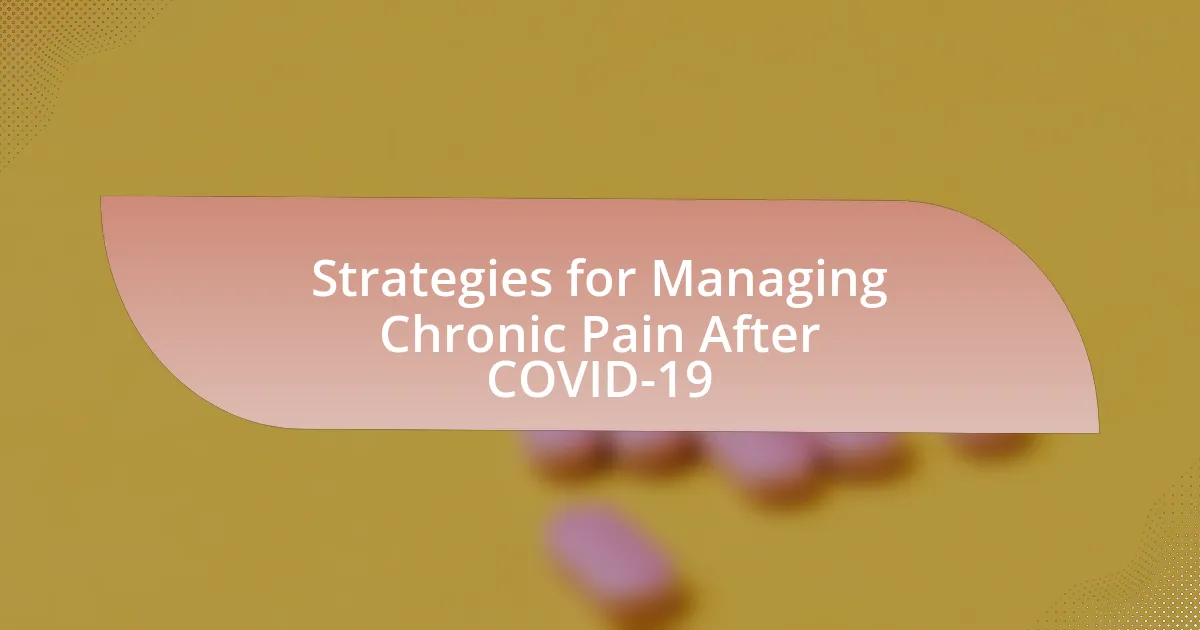The article focuses on strategies for managing chronic pain in individuals recovering from COVID-19. It outlines a multidisciplinary approach that includes physical therapy, medication management, psychological support, and lifestyle modifications to enhance pain management outcomes. Key types of chronic pain reported by COVID-19 survivors include musculoskeletal pain, neuropathic pain, and headaches, with various factors contributing to their persistence. The article emphasizes the importance of tailored exercise programs, effective medication use, and the role of mental health in managing chronic pain, alongside alternative therapies such as acupuncture and massage. Additionally, it discusses the impact of diet, hydration, and community support on pain perception and overall well-being.

What are the key strategies for managing chronic pain after COVID-19?
Key strategies for managing chronic pain after COVID-19 include a multidisciplinary approach that combines physical therapy, medication management, psychological support, and lifestyle modifications. Physical therapy helps improve mobility and strength, while medication management may involve analgesics or anti-inflammatory drugs to alleviate pain. Psychological support, such as cognitive-behavioral therapy, addresses the emotional aspects of chronic pain, and lifestyle modifications, including regular exercise and a balanced diet, contribute to overall well-being. Research indicates that a comprehensive approach enhances pain management outcomes for individuals experiencing post-COVID-19 chronic pain.
How does chronic pain manifest in COVID-19 survivors?
Chronic pain in COVID-19 survivors often manifests as persistent musculoskeletal pain, headaches, and neuropathic pain. Research indicates that approximately 10-30% of individuals recovering from COVID-19 report ongoing pain symptoms, which can arise from inflammation, immune response, or direct viral effects on the nervous system. A study published in the journal “Pain” by Carfì et al. (2020) found that 87% of patients experienced at least one symptom after recovery, with pain being a significant complaint. This highlights the prevalence and impact of chronic pain in this population, necessitating targeted management strategies.
What types of chronic pain are commonly reported post-COVID?
Commonly reported types of chronic pain post-COVID include musculoskeletal pain, neuropathic pain, and headaches. Research indicates that many individuals experience persistent pain in the joints and muscles, often described as widespread or localized discomfort. Neuropathic pain, characterized by sensations such as burning or tingling, has also been frequently reported, particularly among those who experienced severe COVID-19 symptoms. Additionally, headaches, including tension-type and migraine headaches, have been noted as prevalent among post-COVID patients, with studies showing that approximately 10-30% of individuals report ongoing headaches after recovery.
Why do some individuals experience chronic pain after recovering from COVID-19?
Some individuals experience chronic pain after recovering from COVID-19 due to a combination of immune system dysregulation, persistent inflammation, and potential nerve damage caused by the virus. Research indicates that COVID-19 can lead to a hyperactive immune response, which may result in ongoing inflammation that contributes to pain. Additionally, studies have shown that some patients report neuropathic pain, suggesting that the virus may affect nerve pathways. A study published in the journal “Pain” found that approximately 30% of COVID-19 survivors reported chronic pain symptoms months after recovery, highlighting the prevalence of this issue.
What role does physical therapy play in pain management?
Physical therapy plays a crucial role in pain management by employing targeted exercises and techniques to alleviate discomfort and improve function. This approach helps patients regain mobility, strengthen muscles, and reduce pain through individualized treatment plans. Research indicates that physical therapy can significantly decrease pain levels and enhance quality of life for individuals suffering from chronic pain conditions, including those arising post-COVID-19. For instance, a study published in the Journal of Pain Research found that patients who engaged in physical therapy reported a 30% reduction in pain intensity after a structured rehabilitation program.
How can tailored exercise programs help alleviate chronic pain?
Tailored exercise programs can alleviate chronic pain by promoting physical activity that is specifically designed to meet individual needs and limitations. These programs enhance strength, flexibility, and endurance, which can reduce pain levels and improve overall function. Research indicates that structured exercise regimens, such as those outlined in a study published in the Journal of Pain Research by Geneen et al. (2017), demonstrate significant reductions in pain and disability among participants with chronic pain conditions. By addressing the unique physical capabilities and pain triggers of each individual, tailored exercise programs facilitate gradual increases in activity, leading to improved pain management and quality of life.
What specific physical therapy techniques are effective for post-COVID pain?
Specific physical therapy techniques effective for post-COVID pain include graded exercise therapy, manual therapy, and respiratory rehabilitation. Graded exercise therapy involves gradually increasing physical activity to improve endurance and strength, which has been shown to alleviate fatigue and pain in post-COVID patients. Manual therapy, such as soft tissue mobilization and joint manipulation, can help reduce musculoskeletal pain and improve mobility. Respiratory rehabilitation focuses on breathing exercises to enhance lung function and reduce dyspnea, which is common in post-COVID syndrome. Research indicates that these techniques can significantly improve quality of life and functional outcomes for individuals recovering from COVID-19.
How can medication be utilized in managing chronic pain?
Medication can be utilized in managing chronic pain through various classes of drugs, including analgesics, anti-inflammatory medications, and adjuvant therapies. Analgesics, such as acetaminophen and nonsteroidal anti-inflammatory drugs (NSAIDs), provide pain relief by reducing inflammation and blocking pain signals. Opioids may be prescribed for severe pain, although their use is limited due to the risk of addiction. Adjuvant medications, such as antidepressants and anticonvulsants, can also be effective in treating specific types of chronic pain, such as neuropathic pain. Research indicates that a multimodal approach, combining different types of medications, can enhance pain management outcomes and improve quality of life for patients experiencing chronic pain after COVID-19.
What types of medications are commonly prescribed for chronic pain after COVID-19?
Commonly prescribed medications for chronic pain after COVID-19 include nonsteroidal anti-inflammatory drugs (NSAIDs), acetaminophen, opioids, and certain antidepressants like duloxetine. These medications are utilized to manage pain symptoms that persist following COVID-19 recovery. Research indicates that many patients experience ongoing pain, and these medications are often part of a comprehensive pain management strategy, as evidenced by studies showing their effectiveness in alleviating post-viral pain conditions.
How do non-opioid pain relievers compare to opioids in effectiveness?
Non-opioid pain relievers are generally considered less effective than opioids for managing severe pain but can be effective for mild to moderate pain. Research indicates that while opioids provide significant pain relief for acute and severe pain conditions, non-opioid medications, such as NSAIDs and acetaminophen, are often sufficient for chronic pain management and have a lower risk of addiction and side effects. A systematic review published in the Journal of Pain Research found that non-opioid analgesics can effectively reduce pain intensity in various conditions, supporting their use as a first-line treatment in many cases.

What lifestyle changes can support chronic pain management?
Lifestyle changes that can support chronic pain management include regular physical activity, a balanced diet, adequate sleep, stress management techniques, and social support. Engaging in regular physical activity, such as low-impact exercises, has been shown to improve mobility and reduce pain levels in individuals with chronic pain conditions. A balanced diet rich in anti-inflammatory foods can help decrease inflammation, which is often a contributor to chronic pain.
Adequate sleep is crucial, as poor sleep can exacerbate pain sensitivity; studies indicate that individuals with chronic pain often experience sleep disturbances. Stress management techniques, such as mindfulness, yoga, or meditation, can lower stress levels, which are linked to increased pain perception. Lastly, maintaining social connections provides emotional support, which can enhance coping strategies and improve overall well-being in those managing chronic pain.
How does diet impact chronic pain levels?
Diet significantly impacts chronic pain levels by influencing inflammation and overall health. Certain foods, such as those rich in omega-3 fatty acids, antioxidants, and fiber, can reduce inflammation, which is often a contributing factor to chronic pain. For instance, a study published in the journal “Pain” found that diets high in fruits, vegetables, and whole grains are associated with lower levels of inflammatory markers in the body. Conversely, diets high in processed foods, sugars, and saturated fats can exacerbate inflammation and pain. Therefore, dietary choices play a crucial role in managing chronic pain effectively.
What foods should be included or avoided to help manage pain?
To help manage pain, individuals should include anti-inflammatory foods such as fatty fish, nuts, seeds, fruits, and vegetables while avoiding processed foods, sugar, and trans fats. Fatty fish like salmon and mackerel are rich in omega-3 fatty acids, which have been shown to reduce inflammation and pain levels. Nuts and seeds provide healthy fats and antioxidants that can also help mitigate pain. Fruits and vegetables, particularly those high in antioxidants like berries and leafy greens, contribute to overall health and inflammation reduction. Conversely, processed foods and sugars can exacerbate inflammation, leading to increased pain. Research indicates that diets high in refined sugars and unhealthy fats correlate with higher levels of inflammation and chronic pain conditions.
How can hydration influence pain perception?
Hydration can significantly influence pain perception by affecting the body’s physiological processes. Adequate hydration helps maintain optimal cellular function, which is crucial for the transmission of pain signals. Studies indicate that dehydration can lead to increased sensitivity to pain, as it may heighten the perception of discomfort and reduce the effectiveness of pain-relieving mechanisms in the body. For instance, research published in the Journal of Pain Research found that individuals with lower hydration levels reported higher pain intensity and discomfort, demonstrating a direct correlation between hydration status and pain perception.
What role does mental health play in managing chronic pain?
Mental health significantly influences the management of chronic pain by affecting pain perception and coping strategies. Research indicates that individuals with mental health conditions, such as depression and anxiety, often report higher levels of pain and disability. For instance, a study published in the journal Pain in 2020 found that patients with chronic pain and comorbid depression experienced more severe pain and functional impairment compared to those without depression. This relationship underscores the importance of addressing mental health as part of a comprehensive pain management plan, as effective mental health interventions can lead to improved pain outcomes and overall quality of life.
How can mindfulness and meditation techniques assist in pain management?
Mindfulness and meditation techniques assist in pain management by promoting relaxation and altering the perception of pain. These practices help individuals focus on the present moment, reducing anxiety and stress, which are known to exacerbate pain. Research indicates that mindfulness-based stress reduction (MBSR) can lead to significant decreases in chronic pain levels, as evidenced by a meta-analysis published in the Journal of Pain in 2016, which found that MBSR resulted in moderate reductions in pain intensity and improved quality of life for participants. Additionally, studies show that meditation can activate brain regions associated with pain modulation, further supporting its efficacy in managing pain.
What are the benefits of cognitive-behavioral therapy for chronic pain sufferers?
Cognitive-behavioral therapy (CBT) offers several benefits for chronic pain sufferers, including improved pain management, reduced emotional distress, and enhanced coping strategies. CBT helps individuals reframe negative thoughts related to pain, which can lead to decreased perception of pain intensity. Research indicates that patients undergoing CBT report significant reductions in pain-related disability and anxiety levels, as evidenced by a meta-analysis published in the journal Pain, which found that CBT can effectively reduce chronic pain symptoms and improve quality of life. Additionally, CBT equips patients with practical skills to manage pain triggers and stress, fostering a proactive approach to their condition.

What alternative therapies are available for chronic pain management?
Alternative therapies for chronic pain management include acupuncture, chiropractic care, massage therapy, physical therapy, and mindfulness-based stress reduction. Acupuncture has been shown to reduce pain and improve function in various conditions, as evidenced by a meta-analysis published in the Journal of Pain, which found significant pain relief in patients receiving acupuncture compared to control groups. Chiropractic care focuses on spinal manipulation and has been supported by studies indicating its effectiveness in managing lower back pain. Massage therapy can alleviate muscle tension and improve circulation, with research demonstrating its benefits for chronic pain relief. Physical therapy employs exercises and modalities tailored to individual needs, which can enhance mobility and reduce discomfort. Mindfulness-based stress reduction techniques, such as meditation and yoga, have been associated with decreased pain perception and improved quality of life in chronic pain sufferers.
How effective are acupuncture and massage therapy for chronic pain relief?
Acupuncture and massage therapy are effective modalities for chronic pain relief. Research indicates that acupuncture can significantly reduce pain levels, with a meta-analysis published in the Journal of Pain in 2012 showing that acupuncture is more effective than no treatment for chronic pain conditions. Similarly, massage therapy has been shown to alleviate pain, with a systematic review in the Journal of Clinical Psychology in 2015 concluding that massage therapy is beneficial for various types of chronic pain, including back pain and fibromyalgia. Both therapies can enhance overall well-being and improve quality of life for individuals suffering from chronic pain.
What evidence supports the use of acupuncture in post-COVID pain management?
Evidence supports the use of acupuncture in post-COVID pain management through various studies demonstrating its efficacy in alleviating chronic pain symptoms. A systematic review published in the journal “Pain Medicine” in 2021 found that acupuncture significantly reduced pain intensity and improved quality of life in patients with chronic pain conditions, including those recovering from COVID-19. Additionally, a randomized controlled trial conducted by Lee et al. in 2022 indicated that acupuncture provided substantial relief from musculoskeletal pain in post-COVID patients, with participants reporting a 50% reduction in pain levels after a series of treatments. These findings suggest that acupuncture can be an effective complementary therapy for managing pain in individuals experiencing post-COVID complications.
How can massage therapy complement traditional pain management strategies?
Massage therapy can complement traditional pain management strategies by enhancing pain relief, reducing muscle tension, and improving overall well-being. Research indicates that massage therapy can lead to a significant decrease in pain levels, with studies showing that patients receiving massage reported a 30% reduction in pain compared to those who did not receive it. Additionally, massage therapy promotes relaxation and can improve sleep quality, which are crucial for recovery in individuals experiencing chronic pain, particularly after COVID-19. The integration of massage therapy into a comprehensive pain management plan can therefore provide a holistic approach to alleviating discomfort and improving quality of life.
What are the potential benefits of holistic approaches to pain management?
Holistic approaches to pain management can enhance overall well-being by addressing the physical, emotional, and psychological aspects of pain. These methods often include techniques such as mindfulness, acupuncture, and nutritional therapy, which can reduce reliance on pharmaceuticals and minimize side effects. Research indicates that patients utilizing holistic methods report lower pain levels and improved quality of life. For instance, a study published in the Journal of Pain Research found that mindfulness-based stress reduction significantly decreased chronic pain symptoms in participants. This evidence supports the effectiveness of holistic approaches in managing pain comprehensively.
How can yoga and tai chi contribute to pain relief and overall well-being?
Yoga and tai chi contribute to pain relief and overall well-being by promoting physical flexibility, enhancing mental focus, and reducing stress. These practices involve gentle movements and controlled breathing, which can alleviate muscle tension and improve circulation. Research indicates that yoga can reduce chronic pain conditions, such as lower back pain, with a study published in the Journal of Pain Research showing a significant decrease in pain levels among participants who practiced yoga regularly. Similarly, tai chi has been found to improve balance and reduce pain in individuals with arthritis, as evidenced by a systematic review in the Journal of Rehabilitation Medicine that highlighted its effectiveness in pain management. Both practices foster mindfulness, which can lead to improved emotional health and resilience, further enhancing overall well-being.
What role does community support play in managing chronic pain?
Community support plays a crucial role in managing chronic pain by providing emotional, social, and practical assistance to individuals suffering from this condition. Research indicates that social connections can significantly reduce feelings of isolation and depression, which are common among those with chronic pain. For instance, a study published in the journal “Pain” found that individuals with chronic pain who engaged in support groups reported lower pain levels and improved coping strategies. Additionally, community support can facilitate access to resources such as healthcare services, educational programs, and wellness activities, further enhancing pain management.
What practical tips can help individuals manage chronic pain effectively?
To manage chronic pain effectively, individuals should adopt a multi-faceted approach that includes physical activity, mindfulness practices, and proper medication management. Engaging in regular, low-impact exercises such as walking or swimming can enhance mobility and reduce pain levels, as supported by research from the American College of Rheumatology, which emphasizes the benefits of physical activity for chronic pain management. Mindfulness techniques, including meditation and deep-breathing exercises, have been shown to decrease pain perception and improve emotional well-being, according to a study published in the Journal of Pain Research. Additionally, collaborating with healthcare providers to optimize medication regimens ensures that individuals receive appropriate pain relief while minimizing side effects.


